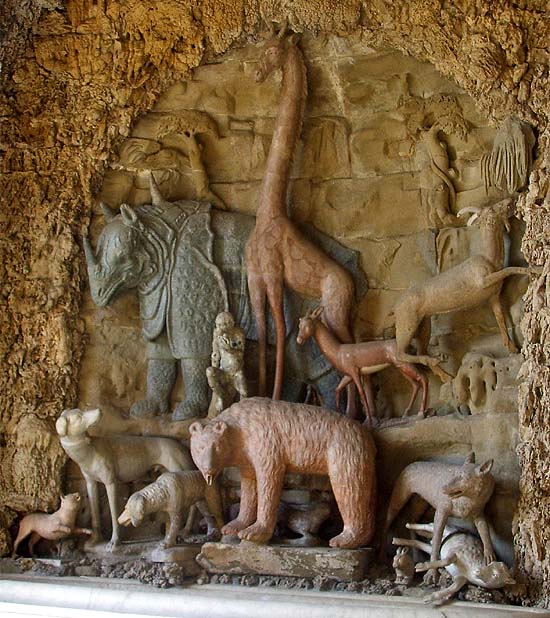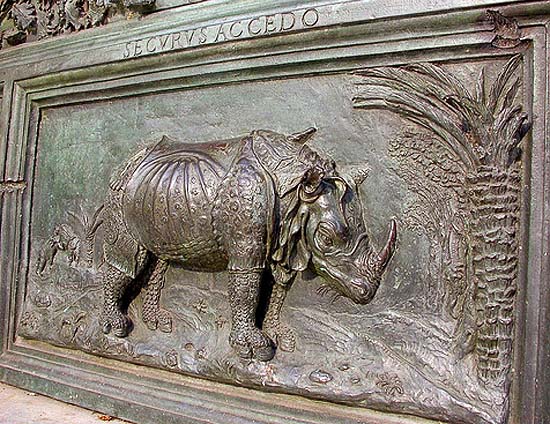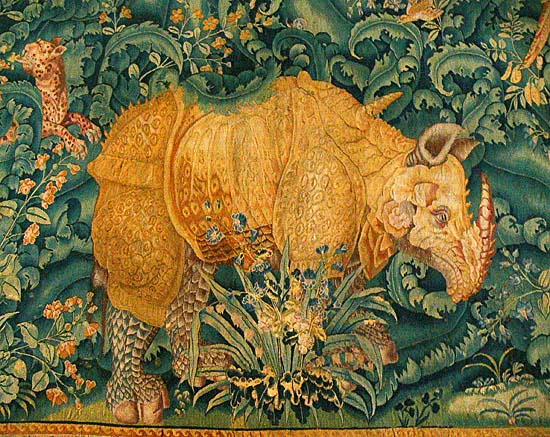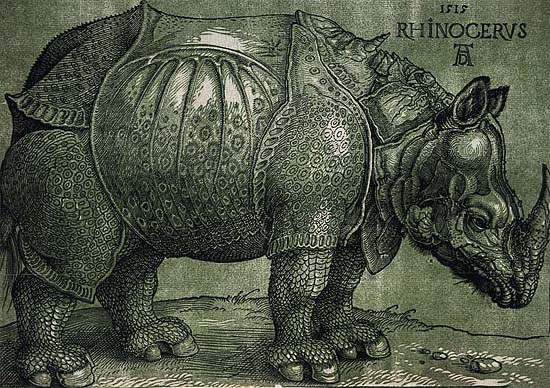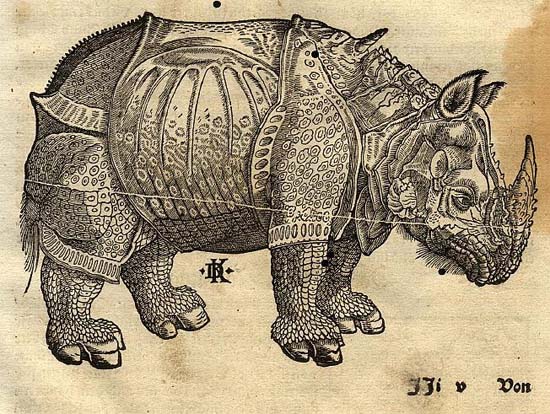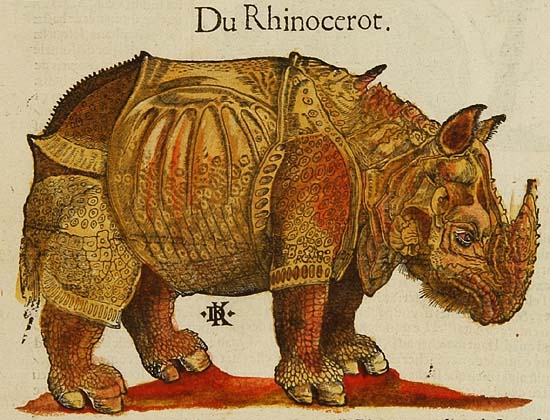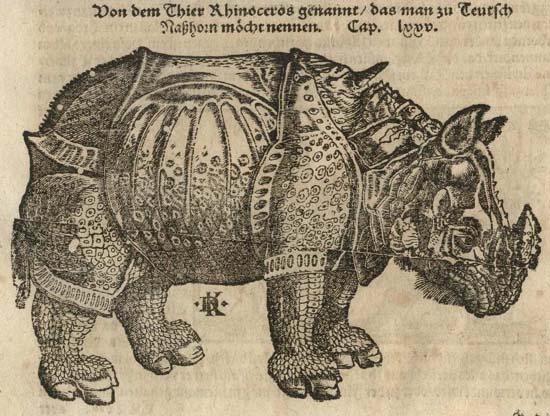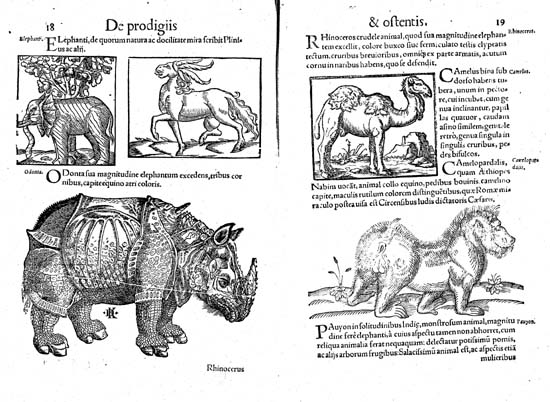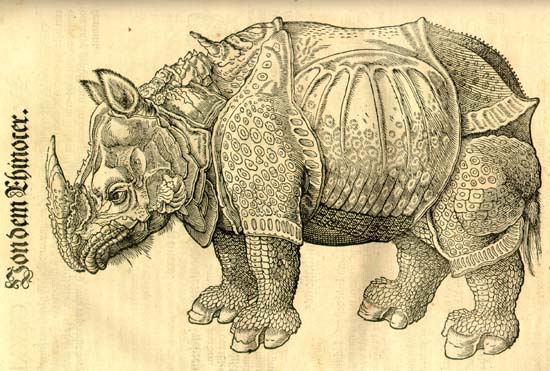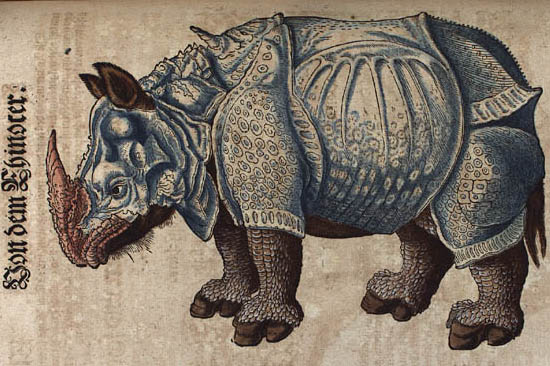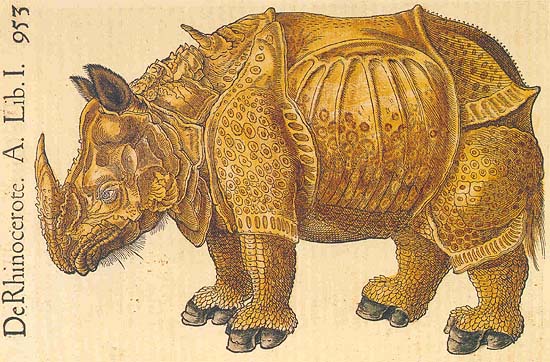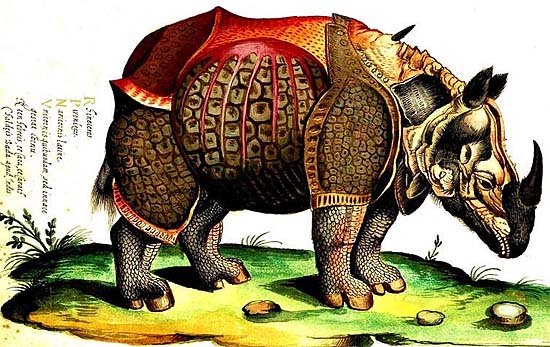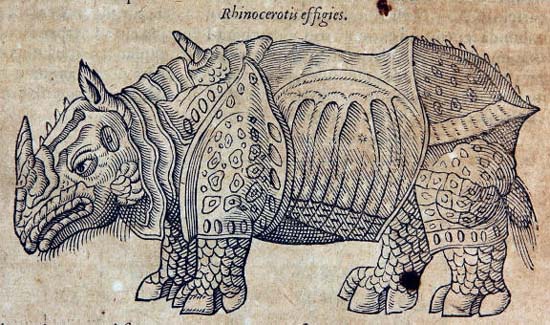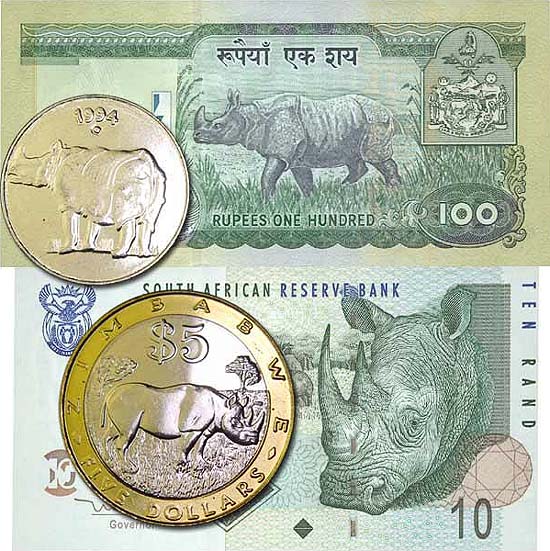
Pierio Valeriano of Bolzano was the first Renaissance humanist who recognized that the enormous amount of recently rediscovered Classical body of knowledge pervading the European civilization had radically changed the symbols of the educated culture, and that it would be a promising business enterprise to compose a dictionary of the new language of symbols
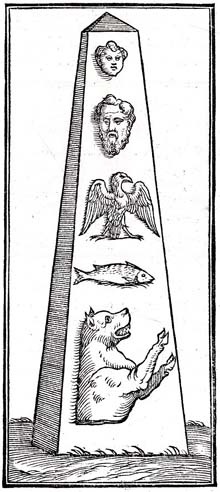
based on the Classical culture, for all those patrons, humanists, painters and writers who wish to appear well-versed in the new erudition. His dictionary of symbols published with the title
Hieroglyphica on almost a thousand folio pages – whose first modern three languages
edition is now being prepared by Studiolum – became a commercial and cultural bestseller. It was published eight times between 1556 and 1678, it was translated in Italian and French, and it was even quoted in the 19th century.
Valeriano collected his corpus from a large number of sources, from Ancient authors to Medieval theologians and from mythological representations to the reliefs of the triumphal columns, but ancient coins had an eminent place in it. These coins were regarded as authoritative historical sources, equal in rank with the written works. As the author of one of the earliest numismatical handbooks Sebastiano Erizzo argued:
Sì come di molte & varie cose, per le istorie habbiamo noi conoscimento, che ogni diletto di tutti gli altri spettacoli & discipline auanzano, così gl’istorici, che di quelle scriuono, spesse fiate con molti errori, opinioni diuerse, & fauole, la verace istoria ci tengono ascosa. A rimedio di ciò, per auiso mio prouidero gli antichi, lasciandoci tanta copia di marmi, di scritture & di bella istoria illustrati; le statue tante & sì varie de i loro Dei, & de gli huomini illustri; i superbi edificij, gli archi notabili, la tanta quantità di antiche medaglie in oro, in argento, & in varij metalli formate. Le quali cose della istoria, & della grandezza de gli antichi ci danno riscontro & testimonianza vera. … Di cotali antichità dilettatomi io sempre, fino dalla mia prima età, 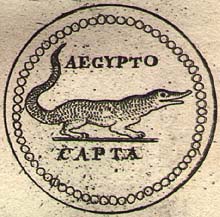 & ricercando parimente tutte le istorie greche & latine, incominciai à voler intendere i riuersi lati delle medaglie antiche, per gli molti & varij libri delle istorie, in tal maniera drizzando il corso di tali studij, che esse medaglie mi seruissero in vece di imagini, & rappresentationi di tante cose belle, che nelle istorie sparse si leggono.
& ricercando parimente tutte le istorie greche & latine, incominciai à voler intendere i riuersi lati delle medaglie antiche, per gli molti & varij libri delle istorie, in tal maniera drizzando il corso di tali studij, che esse medaglie mi seruissero in vece di imagini, & rappresentationi di tante cose belle, che nelle istorie sparse si leggono.
Although we are taught about many different things by the art of history which surpasses the delight of all other entertainments and sciences, nevertheless historians often hide from us the real path of history behind their errors, different opinions and false tales. In my opinion it was for the remedy of this fault that the ancients had left to us in such an abundant amount the marbles decorated with inscriptions and beautiful stories, the statues of their gods and illustrious men, their marvellous buildings, majestic triumphal arches and the great multitude of the ancient coins made out of gold, silver and other metals that give a faithful image and testimony on the history and greatness of the ancients … I myself have found my delight in these since my early age, 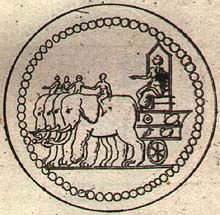 and while I was proceeding in the study of all the Greek and Latin historians, I also started to decypher with their help the reverses of the ancient coins, directing the way of my studies so that I could reveal on these coins the images and representations of all those illustrious things about which we cannot read in histories. (Discorso sopra le medaglie antiche, 1559)
and while I was proceeding in the study of all the Greek and Latin historians, I also started to decypher with their help the reverses of the ancient coins, directing the way of my studies so that I could reveal on these coins the images and representations of all those illustrious things about which we cannot read in histories. (Discorso sopra le medaglie antiche, 1559)It is just obvious therefore that Valeriano, when setting his hand to the entry “Rhinoceros,” started the interpretation of the symbolic images of this animal with a coin:
Qui Rhinoceronta in Domitiani numis inspexêre, quid id signum sibi velit, quaeritare solent. Ego factum id ad Principis adulationem dixerim, qui animalia huiusmodi spectaculis obtulerit.
Those who see the image of the rhinoceros on the coin of Domitianus often inquire about its meaning. I would say that it was made in honor of the emperor who had these animals provided for the spectacles in the circus.
Ancient coins gave origin to a flourishing numismatic literature, whose most important 16th-century representatives will be also
published in the Renaissance series of Studiolum. These works usually grouped by emperors the descriptions and – if the generosity of the patron permitted it – the engraved images of the known coins. Strangely, however, we cannot find in them the coin of Domitian with the rhinoceros. It seems to have been a rare piece, just as its image was somewhat unusual in its own period. In fact, Roman coins which, by way of their similarity to amulets, were also considered a little bit as magic objects, mostly bore the images of protective gods and imperial allegories. Although this coin had been known at least since Valeriano, we have to wait until as late as 1683 for its occurrence in a printed collection. This collection was one of the most authoritative numismatic summaries of the age, the
Thesaurus numismatum imperatorum, published in three folio volumes in Paris by the renowned Bern collectionist and engraver Andreas Morellius. The 1684 edition of the review of the London Royal Society
Philosophical Transactions emphasizes its importance:
This ingenious and diligent Helvetian, as a fair instance what humane industry may effect, if fixt and resolv'd, hath already delineated above twenty thousand different and ancient Coynes, which is a very considerable part of the sorts reserved in the Cabinets of the Princes of Europe, and alsoe an admirable advantage to the Philologist.
In this catalog we find as much as three – or, let us say, two and a half – coins with the rhinoceros, whose pictures we publish here from the Wetstein edition of Morellius’s work (Amsterdam, 1752). On page 497 of the second volume we find this:

and on page 494 this:
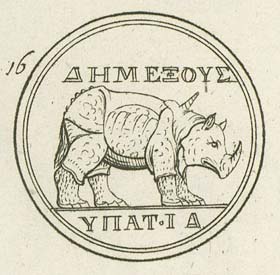
Both coins were issued by Domitian. The above one, made out of bronze, circulated with two different reverses: on one version the animal looked to the left, and on the other version to the right. The other coin was included by Morellius among the golden coins issued in Alexandria and Egypt, and he also translated its Greek inscription in Latin:
“Tribunitia Potestate Consul XIIII.”, that is, “Consul for the 14th time by power of the people’s assembly”, which dates the coin to A.D. 88. On this basis, he gives the following explanation for the representation of the rhinoceros:
Domitiani Consulatus XIIII. incidit in annum V. C. 841. Chr. 88. quo Saeculares Ludos fecit, & Nasamones, & Dacos iterum vicit. Rhinoceros utrumque & ludos & bellum indicat; qui etiam munificentiae, & aeternitatis Imperii est insigne.
Domitianus started his 14th consulate in the 841th year of the foundation of the City, and in the 88th of Christ’s birth, when he organized jubilee spectacles and also defeated the Nasamons and Dacians. The rhinoceros refers both to the spectacles [as Valeriano says] and the war, and it symbolizes both the abundance and the eternity of the empire.
The jubilee spectacles were organized at the centenaries of the foundation of Rome, and the majority of the first emperors made every effort to invent some computation of the time which proved that the anniversary occurred exactly during
their rule. This centenary of Rome was thus celebrated by a number of subsequent Caesars. The spectacles of A.D. 88, especially lavishly organized by Domitian, were even remembered by Suetonius and Martial.
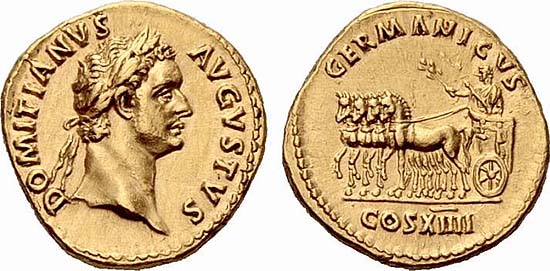 Golden coin of Domitian issued for his 14th consulate, A.D. 88 (RIC 561)
Golden coin of Domitian issued for his 14th consulate, A.D. 88 (RIC 561)The rhinoceroses on these coins remarkably resemble the drawing of Dürer. They have a conspicuous “second horn,” the “dragon-wing pattern” on the “side piece of their armor,” and, in general, the animal’s posture, legs and the structure of its “armor” are just like that of the papal rhinoceros. Is it possible that Dürer supplied from the coins of Domitian for the eventual faults of the sketch of Fernandes? His friend, the Augsburg humanist, antiquarian and imperial councillor Conrad Peutinger with whom they worked together on a number of imperial art commissions – Peutinger on the program and Dürer on the execution – was one of the most renowned collectors of coins of his age, composing in 1511 the first manuscript catalog of the images and titles of Roman emperors on ancient coins. It is highly possible that at least one of the above two coins – if I may have a preference, then the golden one with the dragon-wing pattern – was there in his collection, and that the drawing of Dürer was thus made on the model of a Roman rhinoceros indeed: however, this rhinoceros arrived to Rome one and a half thousand years before the other one left Lisbon.
How good it would be to finish this post here and, sitting back with a laurel placed on our own head, have a good sip of the well deserved Falernum wine! However, there is a small matter left yet.
In the second volume of the standard modern catalog
Roman Imperial Coinage, in chapter “Domitian” we find the following coins with catalog numbers RIC 249 (434) and 250 (435):
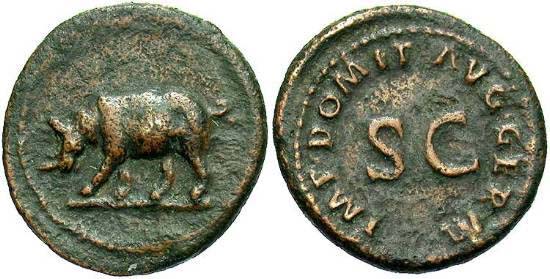
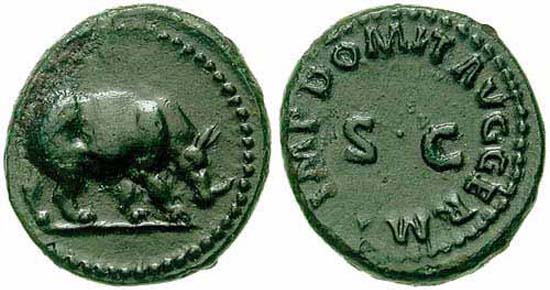
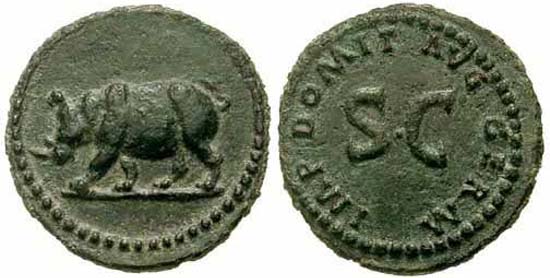
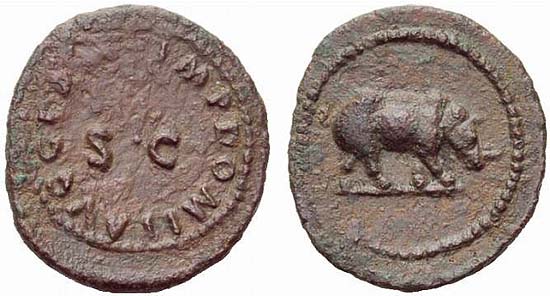
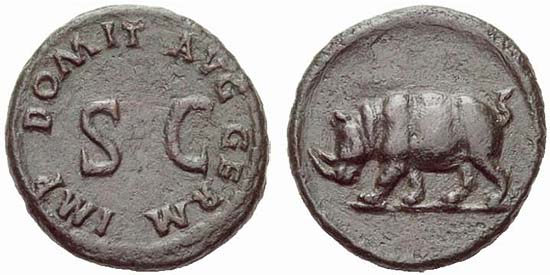
These ones are certainly identical with the bronze coins presented by Morellius, also because there are no more bronze coins with the image of rhinoceros in the whole RIC.
However, these are very different both from Dürer’s drawing and from their own representation in Morellius. They do not have the “second horn” protruding from between their shoulder-blades, they have no “armor” like them, and even their legs are thin like those of cattles and horses on contemporary coins, thus attesting that the artists already at that time adjusted to their accepted visual schemes what they saw.
And the other coin, the golden one with the dragon-wing pattern does not even figure in the RIC.
This fact in itself does not mean that it has never existed. At least Morellius must have seen a copy of it. The RIC is continuously being enlarged, but it is still far from complete. The
Imperatorum Romanorum numismata (1730) of Franciscus Mediobarbus Biragus, for example, also remembers a coin issued in the same year of A.D. 88 with the representation of a rhinoceros
and an elephant
together. The RIC does not know about anything like this either. A large Roman golden coin issued in Egypt with a Greek inscription was certainly a rare item. The one copied by Morellius could have been also lost or it may be hidden somewhere.
However, at the sight of the bronze coins a suspicion arises: did he copy the golden one correctly? Was it not the case which seems to have happened to the bronze ones: that he adjusted the drawing of the Roman coin to the engraving of Dürer as an “authentic representation”?
As the purpose of our present series “Rhinocerology or the power of images” is not to define the exact models of Dürer’s image, but to offer an inside view into the “hidden life,” the mutual attractions and assimilations of Renaissance images, therefore we will be just as satisfied if it will turn out that it was not Dürer who used Domitian’s coins as his models, but Morellius adjusted his representations of the coins to the engraving of Dürer which was, in its turn, made after another indirect model. In this case it will be not Dürer’s image to display a Roman rhinoceros that lived a thousand and five hundred years earlier, but the drawing of Domitian’s coin will represent the animal of Lisbon which was born a thousand and five hundred years after the issue of the coin itself.
and now I don’t know whether
Zhuangzi dreamed of being
a butterfly or the butterfly
dreamed of being Zhuangzi, albeit
a difference between Zhuangzi and the butterfly
certainly there is

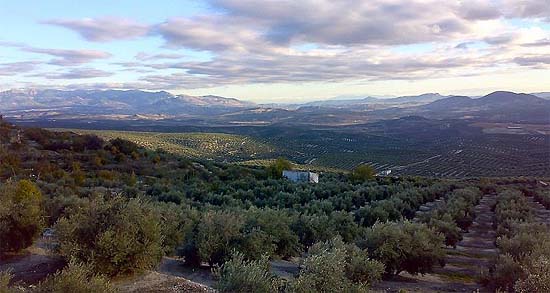
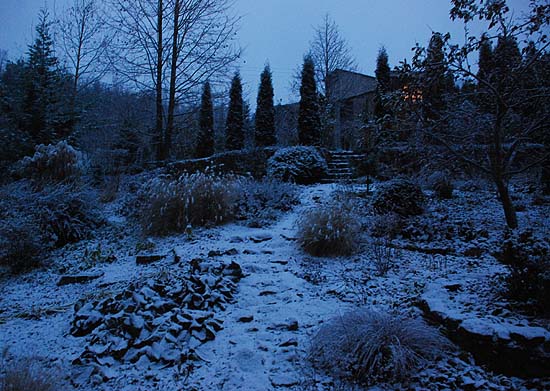
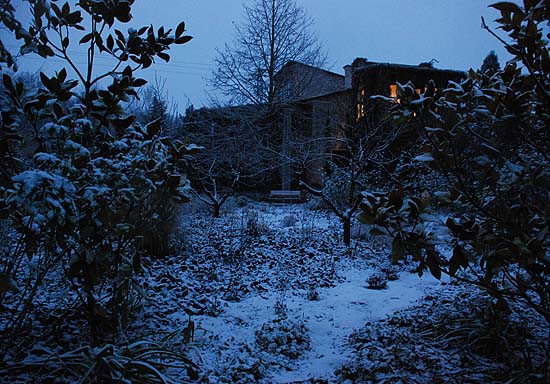
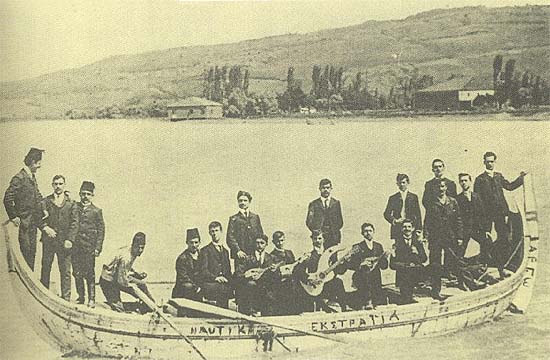
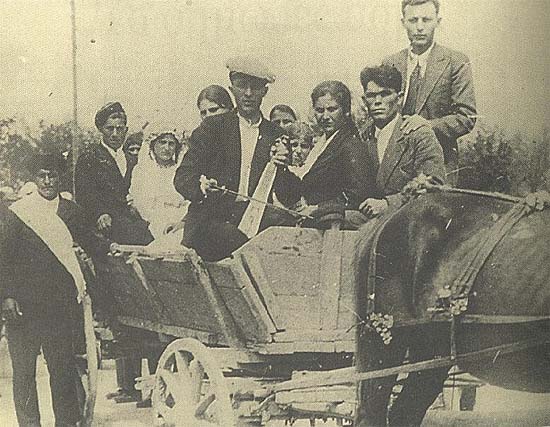
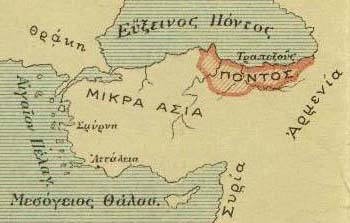 In some periods there lived more Greeks here than in Greece itself, and from time to time they also established an independent state of their own. The first time the Persian dynasty that fled here from Alexander the Great, and whose last king Mithridates fought three sanguinary wars against the Romans before surrendering in 65 B.C. Then in 1204 the Byzantine ruler who fled here from the crusaders invading Constantinople, and whose „Trapezunt Empire” was the last independent Greek state to be conquered in 1461 by the Turks. Finally during WWI the local Greeks left alone by the retiring Russian army and standing up against genocide, who proclaimed
In some periods there lived more Greeks here than in Greece itself, and from time to time they also established an independent state of their own. The first time the Persian dynasty that fled here from Alexander the Great, and whose last king Mithridates fought three sanguinary wars against the Romans before surrendering in 65 B.C. Then in 1204 the Byzantine ruler who fled here from the crusaders invading Constantinople, and whose „Trapezunt Empire” was the last independent Greek state to be conquered in 1461 by the Turks. Finally during WWI the local Greeks left alone by the retiring Russian army and standing up against genocide, who proclaimed 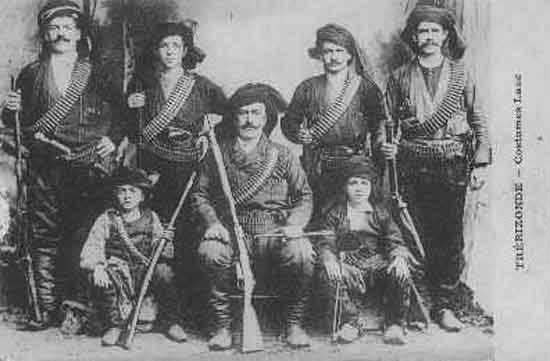
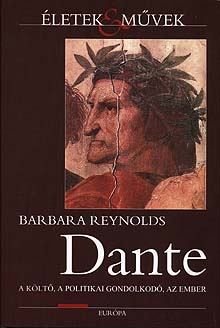
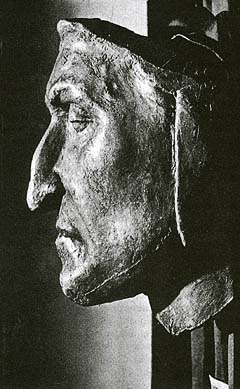
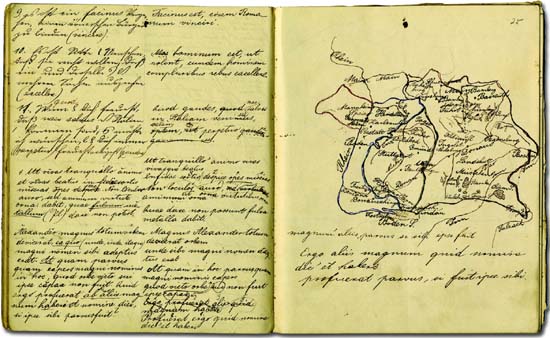
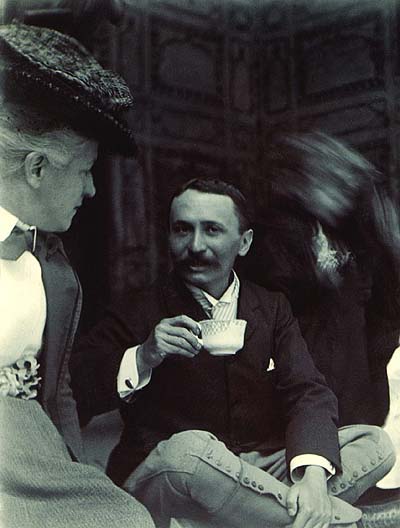

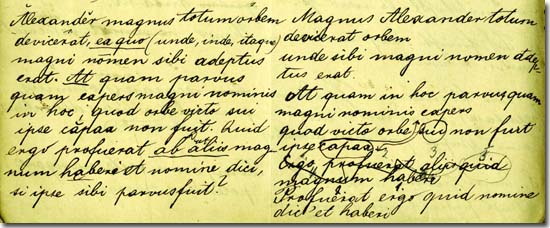
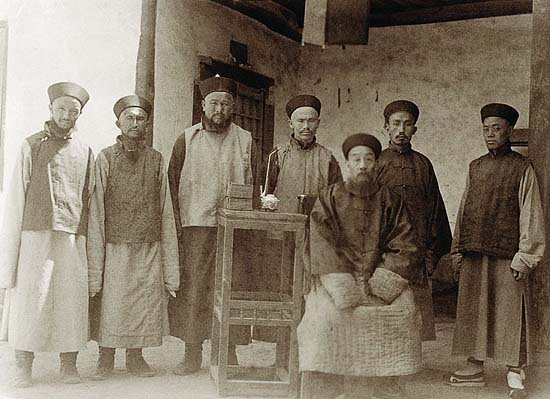
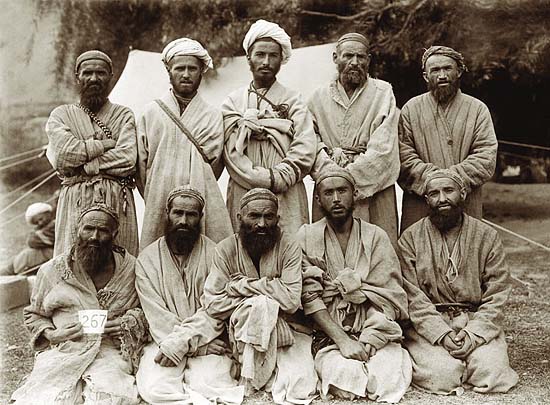
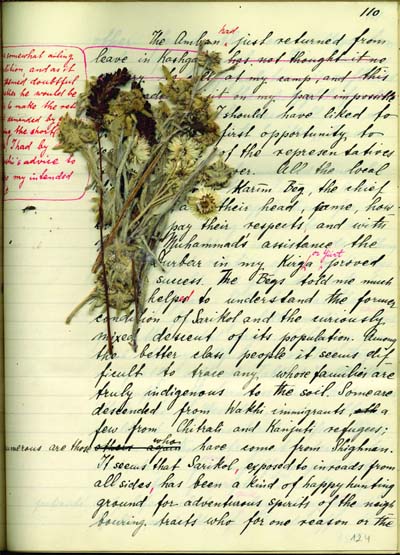
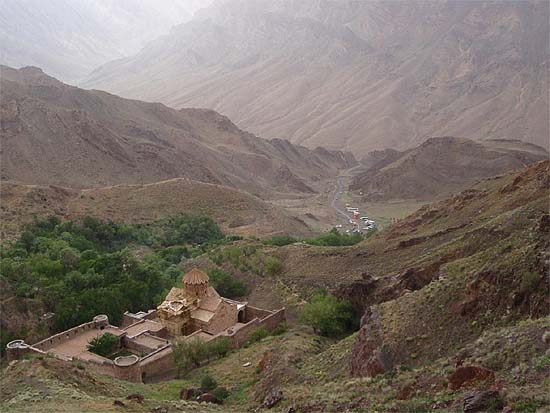
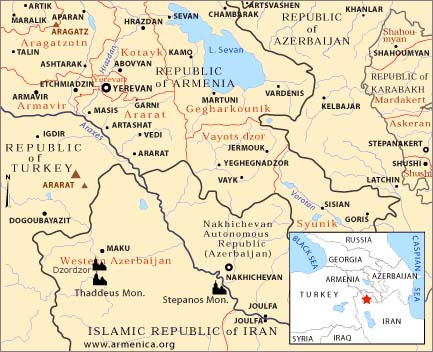
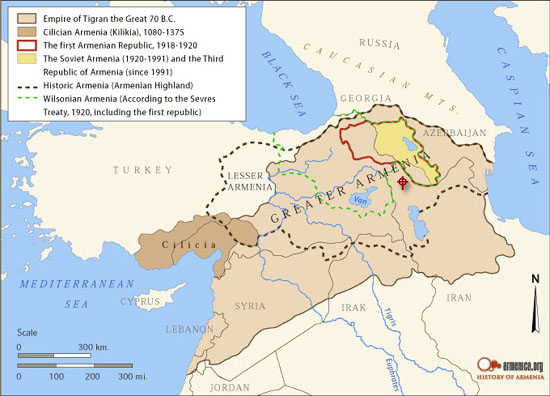
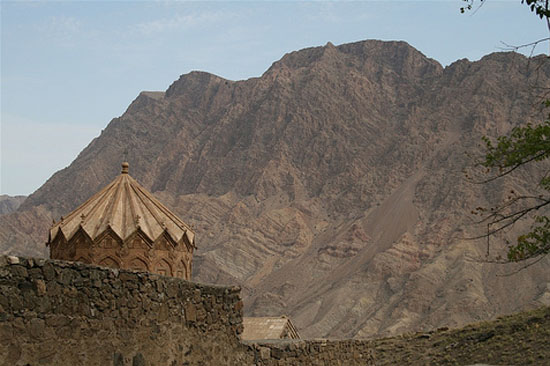
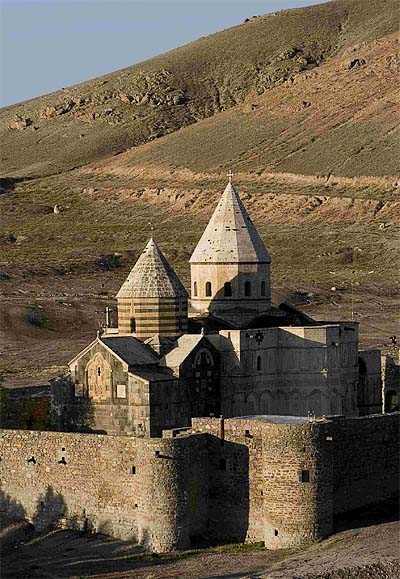
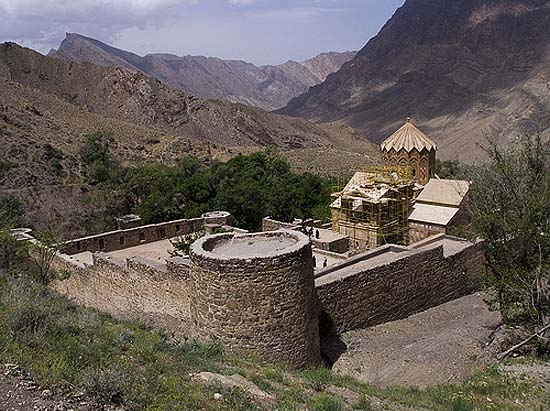
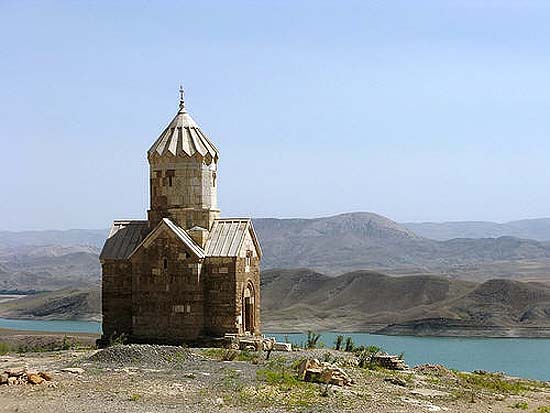
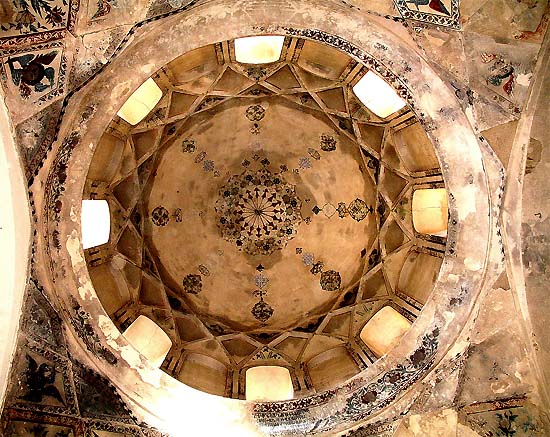
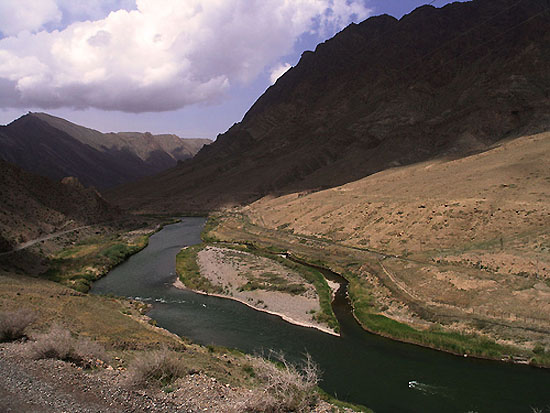
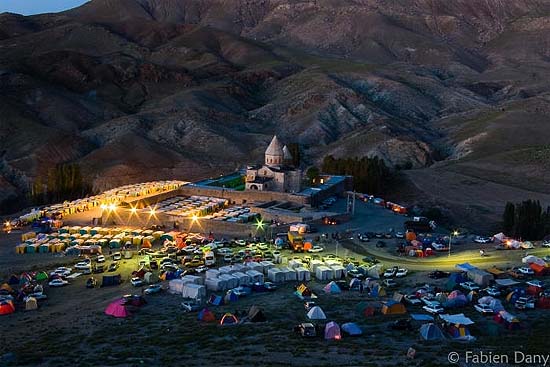
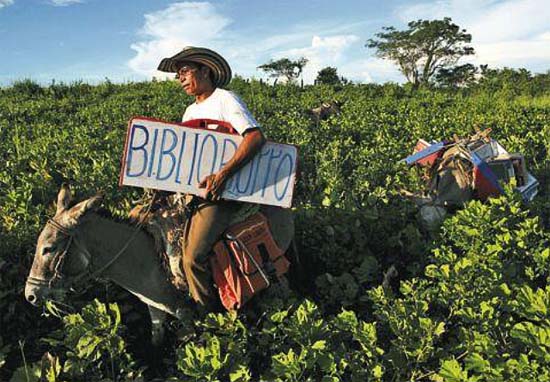
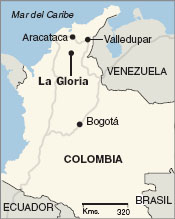 the elementary school teacher Luis Soriano, and of four thousand eight hundred books begged together from various sources. Obviously only a small part of them moves around at every weekend on the mountain paths around the Columbian village of La Gloria, about which the yesterday article of the Spanish edition of the New York Times presenting the library says to be even more abandoned than Aracataca, the Macondo of Gabriel García Márquez’s
the elementary school teacher Luis Soriano, and of four thousand eight hundred books begged together from various sources. Obviously only a small part of them moves around at every weekend on the mountain paths around the Columbian village of La Gloria, about which the yesterday article of the Spanish edition of the New York Times presenting the library says to be even more abandoned than Aracataca, the Macondo of Gabriel García Márquez’s 